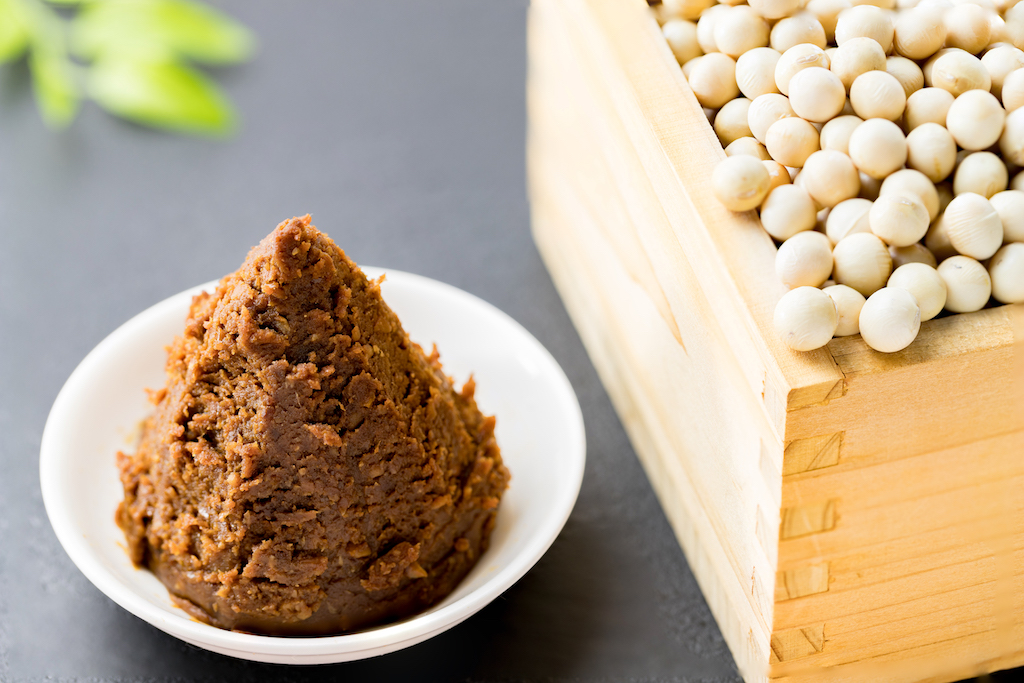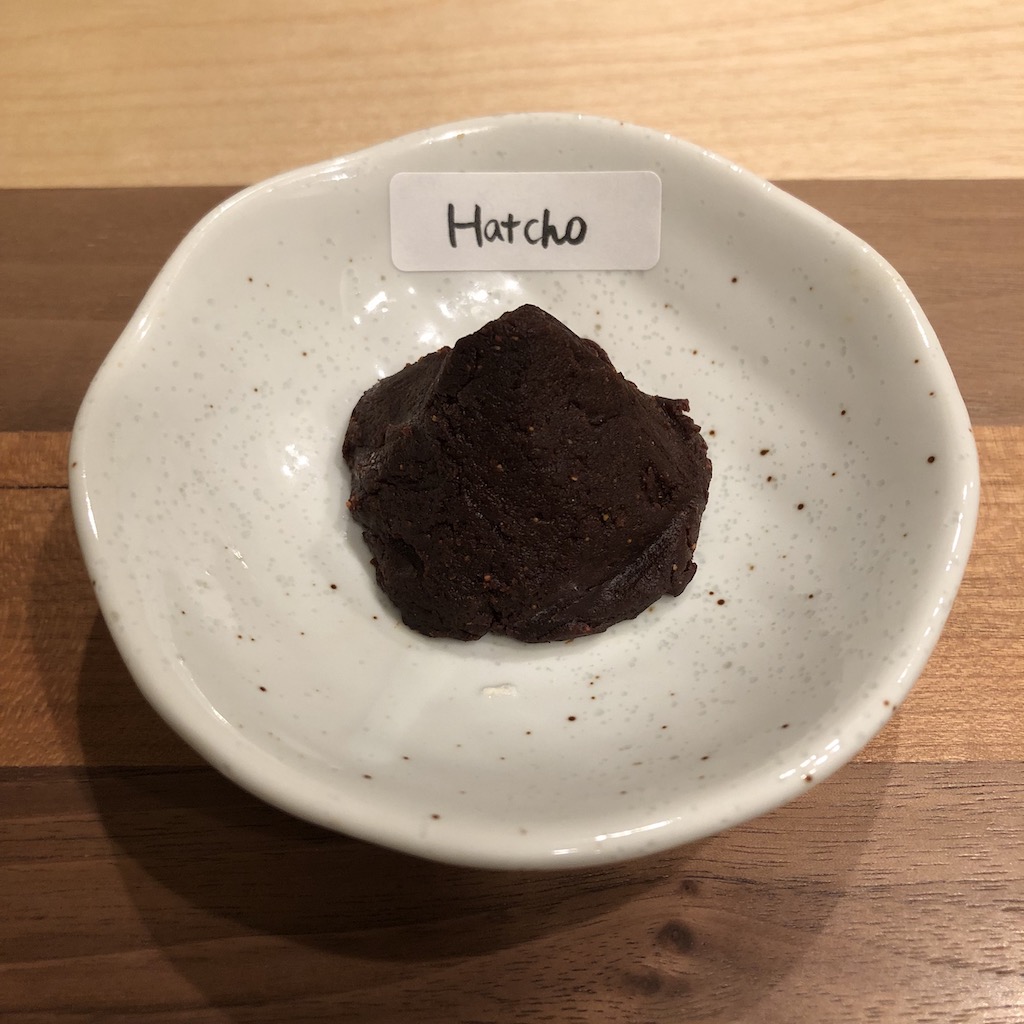The color of miso is roughly divided into 3 types: Red, Golden yellow, and White according to finished color.
The color varies by the kinds of raw materials and how to make, and there are so many different colors. But typically people use only 3 kinds of color for convenience sake.
For here, I would like to explain the difference between red miso and white miso. Those two kinds are often seen at the miso section in a store and on the miso package. (Even Japanese don’t really use the name “golden yellow miso” by the way.)
Interested in learning more about categorizing miso?
[Ultimate Guide] Different Types of Miso
About Red Miso
What Is Red Miso (赤味噌 Aka Miso)?
Red miso is generic name for miso with a reddish appearance. Regardless of raw materials and manufacturing method, we call it red miso as long as the appearance is brown and reddish brown.
The taste of red miso varies from sweet to salty depending on raw materials and manufacturing method. But most of them have salty taste which salinity is about 10%. Sodium per 1 Tbsp (18g) in typical red miso: 709mg*
*Calculated as 10% salinity
Due to the relatively cool area, Eastern Japan is the larger producer of red miso than Western Japan. 
Although there are exceptions, basically red miso has following features in manufacturing method.
Use steamed (not boiled) soybean before mixing with koji
When the soybeans are steamed at high temperature for long time, the amino acids contained in soybeans react with sugar, and its color turn brown during maturing process. (It’s called “Maillard reaction”.)
Long aging period
Miso produced in Eastern Japan needs longer aging period than Western Japan because of lower temperature in that region.
Due to the long aging period, miso needs comparatively large amount of salt.
Another reason for the need of long aging period is that red miso usually contains less amount of koji than white miso, and it means more function of microorganisms such as yeast and lactic acid bacteria are needed in order to mature completely.
Aging period
[Red Miso] Typical rice miso and barley miso: 3 months – 1 year
[Red Miso] Soybean miso, Hatcho miso: 1-3 years
[White Miso]: 1 week – 3 months
Stir miso frequently during maturing process
As I mentioned above, functions of microorganisms such as yeast and lactic acid bacteria are crucial to complete fermentation. Stirring miso let miso been exposed to the air and can accelerate this function during maturing process.
This stirring work could be omitted depending on the shape and size of container.
Different Types of Red Miso
There are various types of red miso, and some examples are the following.
Typical Rice Miso (Brown Color)

Rice miso means its raw materials are soybean, koji rice, and salt.
Rice miso is produced the most in Japan (80% of all miso in Japan).
Although a lot of white miso are also categorized as rice miso, rice miso produced in Easter Japan is more likely to be red miso and salty.
I would say people call miso “red miso” as long as it’s brownish color including light brown and not obviously white (pale-yellow).
Typical rice miso recipe: Best Miso Fried Rice Recipe
Soybean Miso
Soybean miso is mainly produced in Tokai region (Aichi, Gifu, Mie, etc). It’s dark reddish-brown in color.
The biggest feature is that it doesn’t contain koji rice neither barley koji, but it uses only soybean koji. That’s why it’s not sweet but has unique bitter taste and umami.
For people in Tokai region, speaking of red miso, it’s usually this soybean miso.
Soybean miso recipe: SHISO (JAPANESE BASIL) MISO RECIPE
Hatcho Miso

Hatcho miso is representative soybean miso, which is produced in specific area in Aichi prefecture. The name of miso comes from the place of production: Haccho cho, Okazaki-city, Aichi prefecture.
The two most famous manufacturer of Hatcho miso are now Maruya and Kakukyu.
Tokai region has climate of high temperature and high humidity, and it sometimes makes miso rotten. To prevent from rotting, soybean miso using traditional “miso-ball manufacturing method” is created in this area.
Interested in learning more about Hatcho miso?
What Is HATCHO MISO and How Is It Used?
Aka-Dashi
Akadashi is soybean miso-based blended miso, and what to mix with soybean miso is depending on the brand. Generally it’s mixing with rice miso and seasonings such as dashi.
Since it’s soybean miso-based miso, the color is very similar to soybean miso which is dark reddish-brown. The taste is also like that, it’s not sweet and a little bit bitter. But at the same time you can feel dashi flavor and a little bit of sweetness comes from rice miso.
Some of them don’t contain dashi, however basically it does as its name suggests.
Aka-dashi recipe: BEST MISO RAMEN (Recipe)
Edo-Amamiso
Edo is a old name for Tokyo, and amamiso means sweet miso. It’s traditional miso that has been produced and eaten around Tokyo.
Edo-amamiso contains plenty of koji rice, and has sweet taste.
Unlike other red miso, the aging period of Edo-amamiso is very short, about 10 days. Despite of this short aging period, it becomes very dark brown in color because soybeans are not boiled but steamed in the manufacturing process.
About White Miso
What Is White Miso (白味噌 Shiro Miso)?
White miso is generic name for miso with a whitish appearance. Regardless of raw materials and manufacturing method, we call it white miso as long as the appearance is white (pale-yellow).
The taste of white miso varies from sweet to salty depending on raw materials and manufacturing method.
Western Japan where the weather is warmer than Easter Japan is the larger producer of white miso than Eastern Japan. And several famous white miso produced in Western Japan are mostly sweet miso.
Sodium per 1 Tbsp (18g) in typical sweet white miso: 354mg*2
*2Calculated as 5% salinity ▲Saikyo Miso
▲Saikyo Miso
Although there are exceptions, basically white miso has following features in manufacturing method.
Use boiled (not steamed) soybean before mixing with koji
By boiling, protein contained in soybeans that are required for the action of making miso brown will be dissolved in hot water and lost. That means “Maillard reaction” doesn’t occur, and miso turns white.
Short aging period
White miso is matured for short term: few days at the least and 3 months at the most.
Also white miso uses a large amount of koji (approximately twice the amount of koji compared to raw soybean), so abundant koji produce a lot of sugar during short aging period at high temperature (around 122 degrees [F] / 50 degrees [C]).
Aging period
[Red Miso] Typical rice miso and barley miso: 3 months – 1 year
[Red Miso] Soybean miso, Hatcho miso: 1-3 years
[White Miso]: 1 week – 3 months
Hardly stir miso during maturing process
Sweet white miso has short aging period, so you don’t have to stir during maturing process.
Different Types of White Miso
The followings are representative white miso.
Saikyo Miso (Kansai White Miso)
Kansai white miso is sweet white miso produced in Kansai region (Osaka, Kyoto, Nara, etc). Saikyo miso is one of Kansai white miso, and produced in Kyoto prefecture according to strict standards.
To make it glossy those white miso often contain refined sugar (mizuame in Japanese).
Interested in learning more about Saikyo miso?
What Is Saikyo Miso and How Is It Used?
Sanuki White Miso
Sanuki white miso is sweet white miso produced in Kagawa prefecture (Sanuki is old name for Kagawa). People there developed Sanuki miso as high-class goods using high-quality local rice (rice koji) after the war. Now you can purchase it at more reasonable price.
There is local food called Sanuki Oden (oden is fishcake and vegetable stew), and its sauce made from sweet white miso and mustard. ▲Sanuki Oden
▲Sanuki Oden
Fuchu White Miso
Fuchu white miso is sweet white miso produced in around Fuchu area (Fuchu is the city in Hiroshima prefecture). Like Sanuki miso, it had used high-quality local rice (rice koji) and sold as high-class goods.
The representative Fuchu miso is sweet white miso, but they also produce various kind of miso including red miso now.
All of 3 kinds of white miso above are sweet, low sodium, and made with koji rice (it’s called rice miso).
 ▲Ozoni
▲Ozoni
Shinshu Koji Miso
Not as white as above, but Shinshu koji miso is also categorized as white miso. Shinshu miso is produced in Nagano prefecture (Shinshu is old name for Nagano). Miso produced in Nagano using a large amount of koji is called “Shinshu koji miso” or “Shinshu white miso”. The taste of this is totally different from the above 3 kinds, it has mild but salty taste.
Interested in learning more about Shinshu koji miso?
What Is Shinshu Koji Miso?
By the way, miso produced in Nagano are both red and white miso, and sometimes they are called golden yellow miso (Yamabuki miso in Japanese) because of its color. Also there is a miso brand name called Yamabuki.


